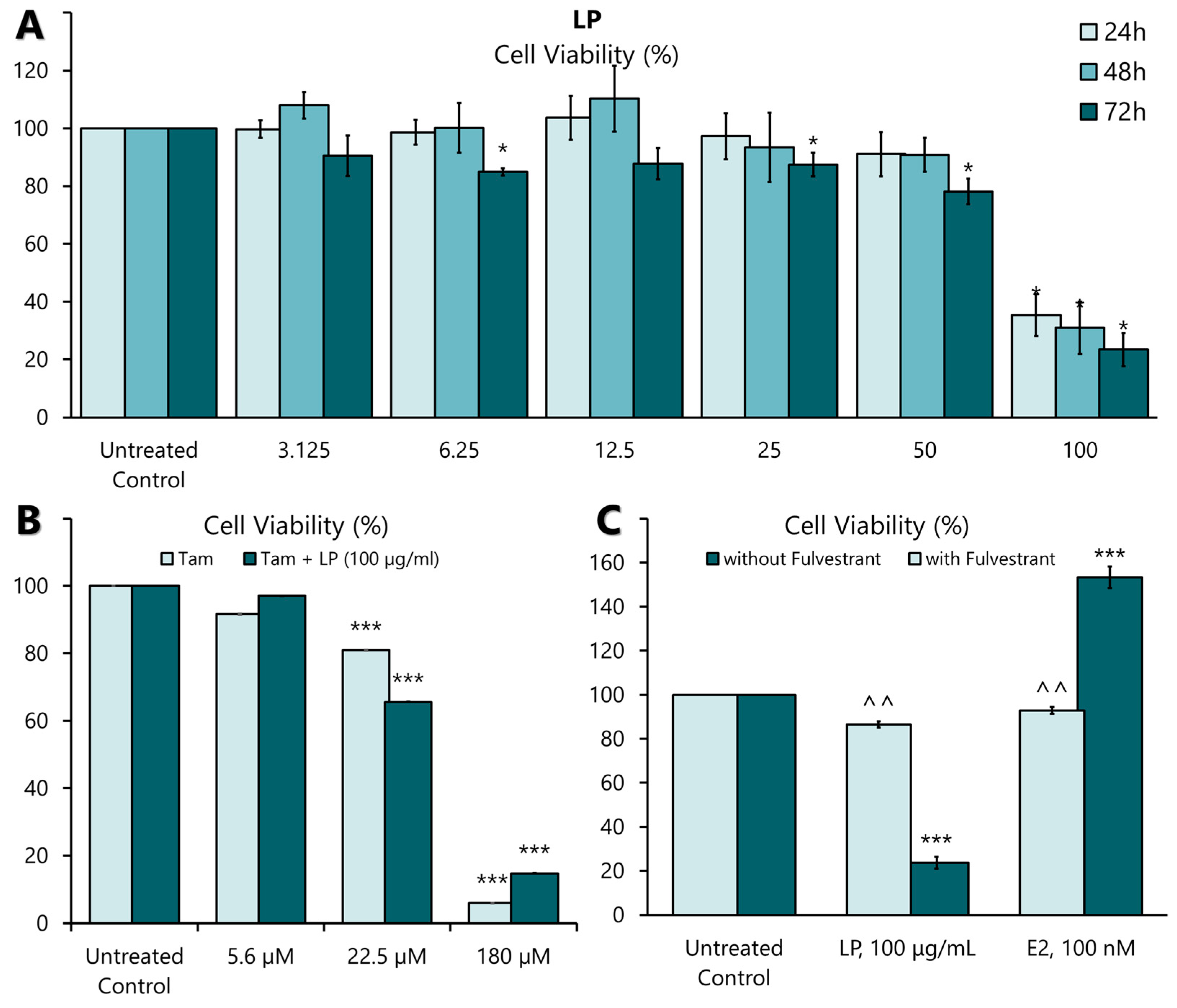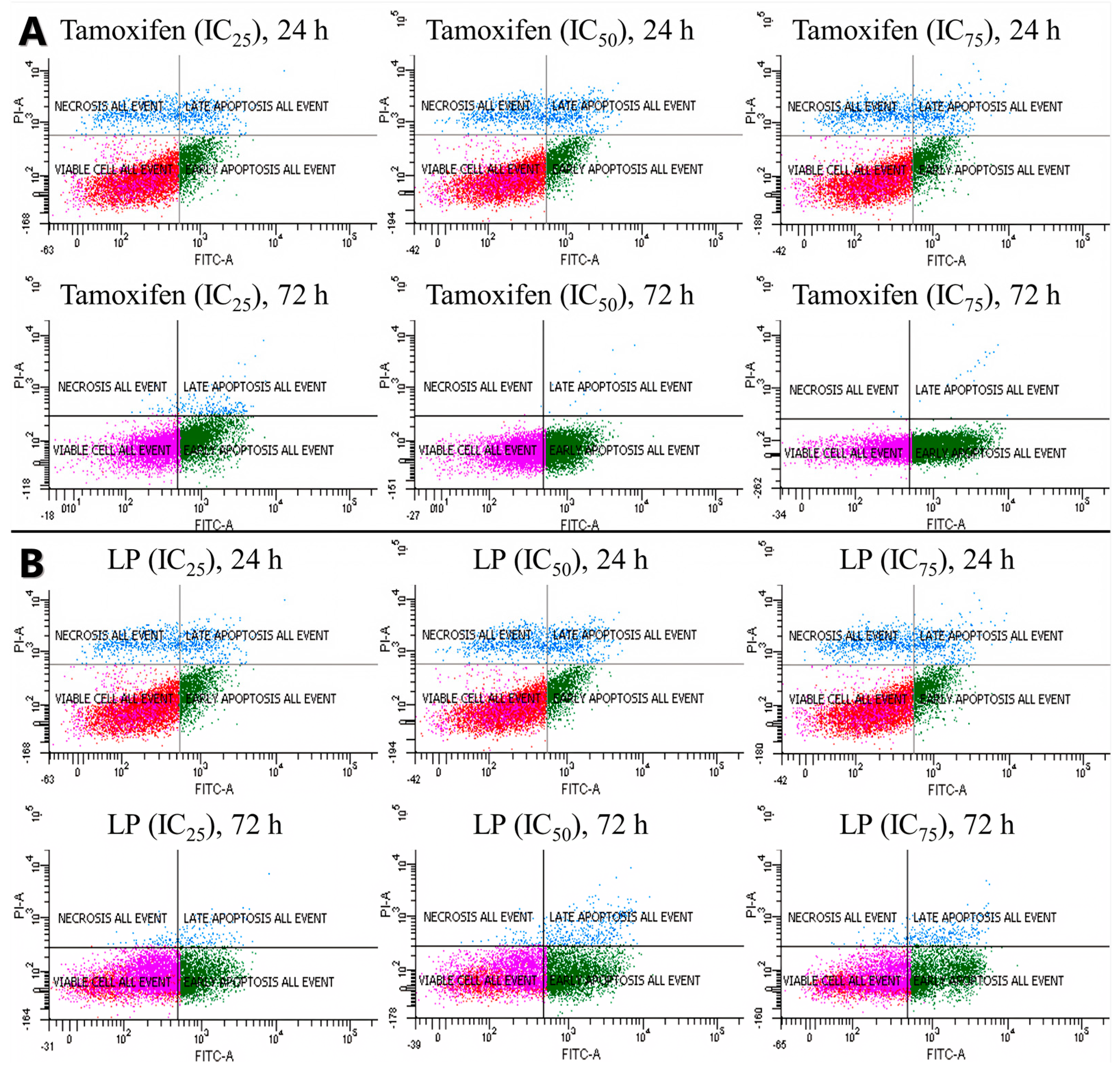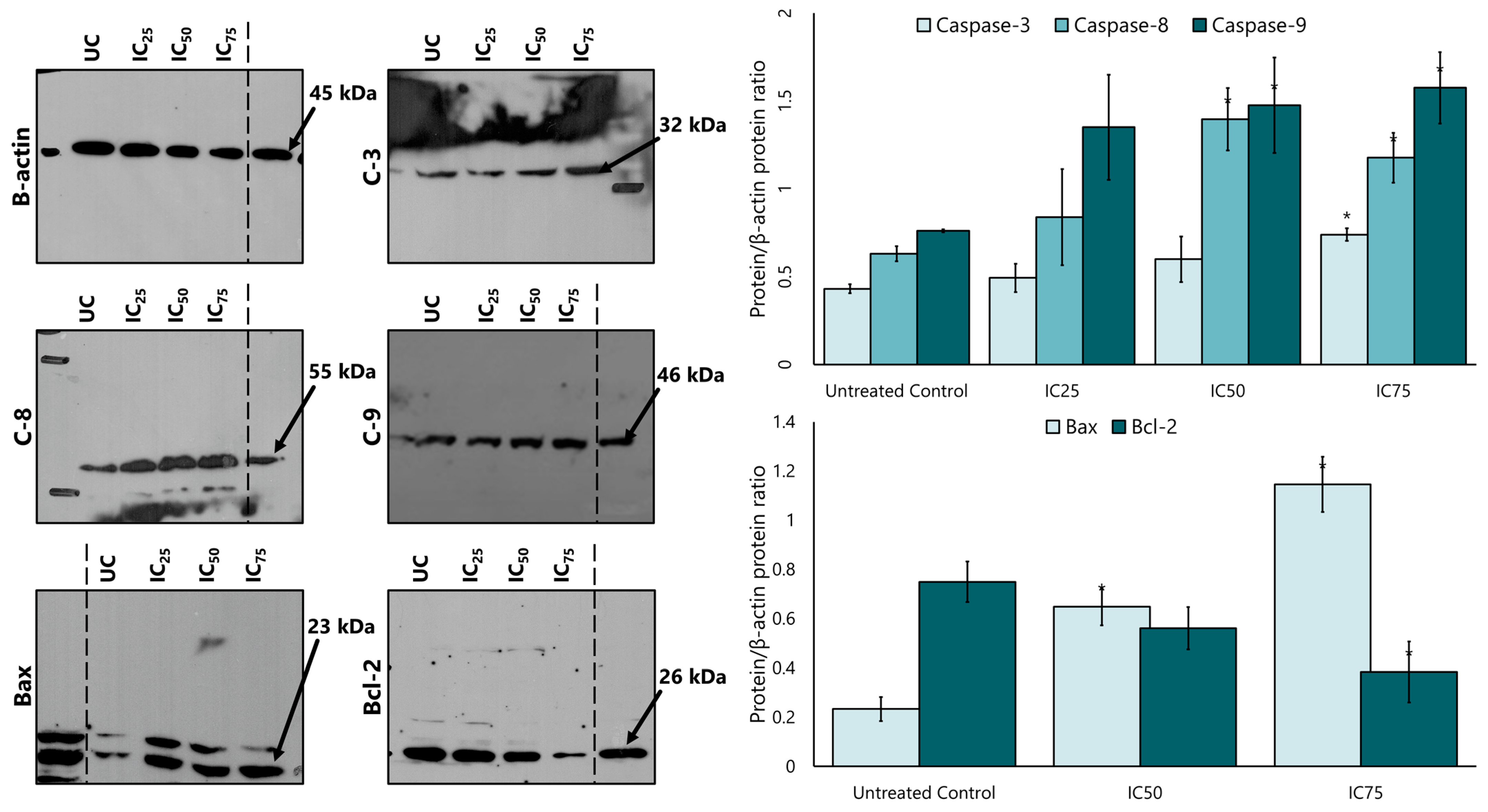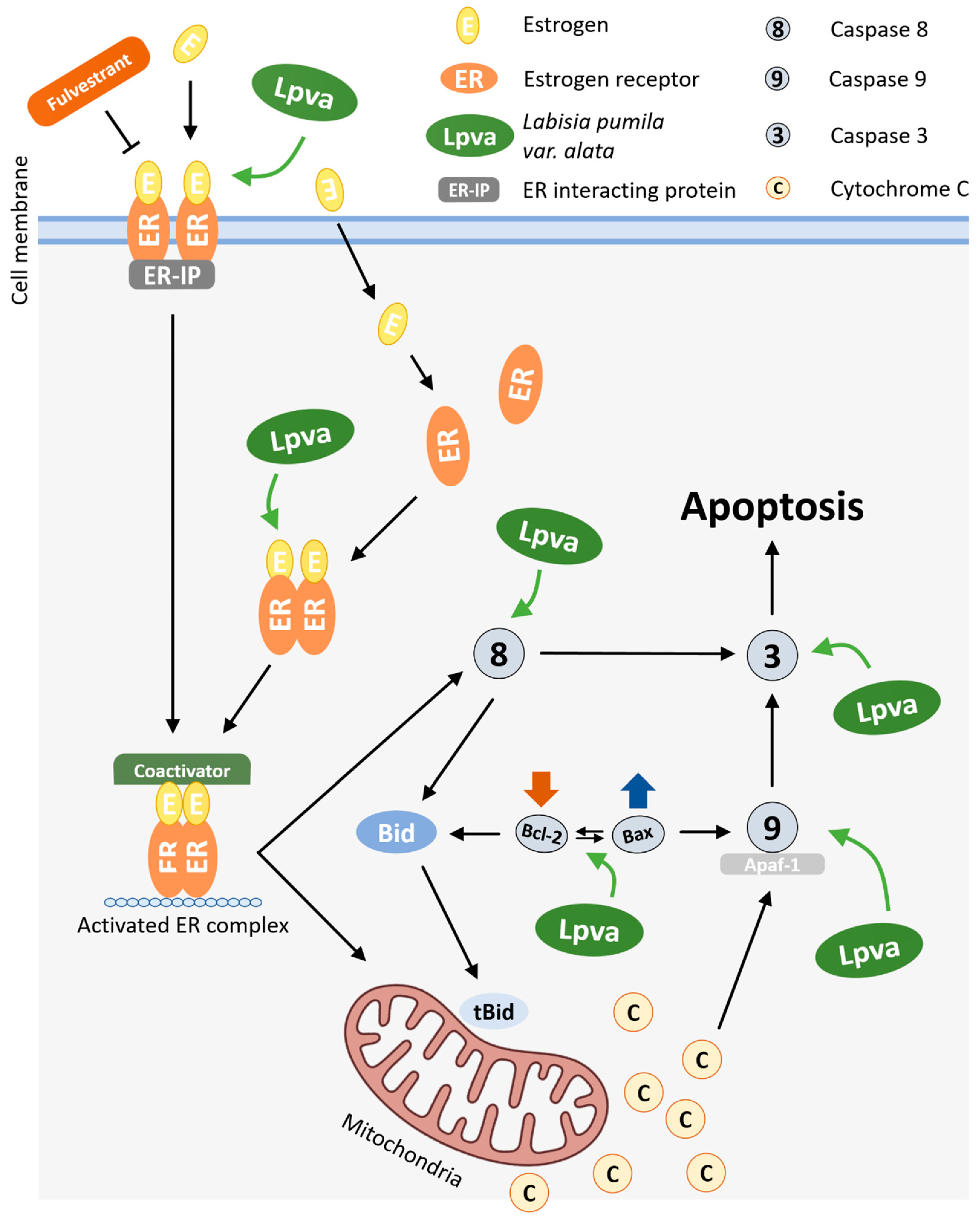Labisia pumila var. alata Extract Induces Apoptosis Cell Death by Inhibiting the Activity of Oestrogen Receptors in MCF-7 Breast Cancer Cells
Abstract
1. Introduction
2. Results
2.1. Molecular Docking Simulation of LP’s Phytoestrogens on Oestrogen Receptors
2.2. Competitive Binding of LP Extracts to the Oestrogen Receptor
2.3. Inhibition of MCF-7 Cell Proliferation Using LP Extract
2.4. Oestrogen Receptor-Dependent Activity of LP Extracts in MCF-7 Cells
2.5. Flow Cytometry Analysis of the Apoptotic Activity of LP Extracts
2.6. Expression of Apoptotic Markers in MCF-7 Cells by LP Extracts
3. Discussion
4. Materials and Methods
4.1. Materials
4.2. Sample Preparation
4.3. Molecular Docking Analysis and Simulations
4.4. Oestrogen Receptor Binding Assay
4.5. Cell Culture and Maintenance
4.6. MTT Assay
4.7. Flow Cytometry Apoptosis Analysis
4.8. Western Blot Analysis
4.9. Statistical Analysis
5. Conclusions
Author Contributions
Funding
Institutional Review Board Statement
Informed Consent Statement
Data Availability Statement
Acknowledgments
Conflicts of Interest
References
- Bray, F.; Laversanne, M.; Sung, H.; Ferlay, J.; Siegel, R.L.; Soerjomataram, I.; Jemal, A. Global Cancer Statistics 2022: GLOBOCAN Estimates of Incidence and Mortality Worldwide for 36 Cancers in 185 Countries. CA Cancer J. Clin. 2024, 74, 229–263. [Google Scholar] [CrossRef] [PubMed]
- World Health Organization. Public Health Data at a Glance: Malaysia; World Health Organization: Geneva, Switzerland, 2019. [Google Scholar]
- Godone, R.L.N.; Leitão, G.M.; Araújo, N.B.; Castelletti, C.H.M.; Lima-Filho, J.L.; Martins, D.B.G. Clinical and Molecular Aspects of Breast Cancer: Targets and Therapies. Biomed. Pharmacother. 2018, 106, 14–34. [Google Scholar] [CrossRef]
- Farooqui, M.; Hassali, M.A.; Shatar, A.K.A.; Farooqui, M.A.; Saleem, F.; ul Haq, N.; Othman, C.N. Use of Complementary and Alternative Medicines among Malaysian Cancer Patients: A Descriptive Study. J. Tradit. Complement. Med. 2016, 6, 321–326. [Google Scholar] [CrossRef] [PubMed]
- Hanahan, D.; Weinberg, R.A. Hallmarks of Cancer: The next Generation. Cell 2011, 144, 646–674. [Google Scholar] [CrossRef] [PubMed]
- Clemons, M.; Goss, P. Estrogen and the Risk of Breast Cancer. N. Engl. J. Med. 2001, 344, 276–286. [Google Scholar] [CrossRef]
- Duan, Z.; Wei, B.; Deng, J.; Mi, Y.; Dong, Y.; Zhu, C.; Fu, R.; Qu, L.; Fan, D. The Anti-Tumor Effect of Ginsenoside Rh4 in MCF-7 Breast Cancer Cells in Vitro and in Vivo. Biochem. Biophys. Res. Commun. 2018, 499, 482–487. [Google Scholar] [CrossRef]
- Ahn, S.Y.; Jo, M.S.; Lee, D.; Baek, S.E.; Baek, J.; Yu, J.S.; Jo, J.; Yun, H.; Kang, K.S.; Yoo, J.E.; et al. Dual Effects of Isoflavonoids from Pueraria Lobata Roots on Estrogenic Activity and Anti-Proliferation of MCF-7 Human Breast Carcinoma Cells. Bioorg. Chem. 2019, 83, 135–144. [Google Scholar] [CrossRef]
- Kaushik, S.; Shyam, H.; Sharma, R.; Balapure, A.K. Dietary Isoflavone Daidzein Synergizes Centchroman Action via Induction of Apoptosis and Inhibition of PI3K/Akt Pathway in MCF-7/MDA MB-231 Human Breast Cancer Cells. Phytomedicine 2018, 40, 116–124. [Google Scholar] [CrossRef]
- Liu, B.; Zhang, J.; Liu, W.; Liu, N.; Fu, X.; Kwan, H.; Liu, S.; Liu, B.; Zhang, S.; Yu, Z.; et al. Calycosin Inhibits Oxidative Stress-Induced Cardiomyocyte Apoptosis via Activating Estrogen Receptor-α/β. Bioorg. Med. Chem. Lett. 2016, 26, 181–185. [Google Scholar] [CrossRef]
- Jamaludin, N.; Hasham, R.; Ware, I.; Sarmidi, M.R.; Abd Aziz, R. Antiproliferative Properties of Aqueous Labisia pumila Extract on Prostate Cancer Cell Lines. J. Teknol. 2015, 77, 61–66. [Google Scholar] [CrossRef]
- Giménez-Bastida, J.A.; González-Sarrías, A. Dietary Bioactive Compounds and Breast Cancer. Int. J. Mol. Sci. 2023, 24, 9731. [Google Scholar] [CrossRef]
- Chen, F.P.; Chien, M.H. Phytoestrogens Induce Apoptosis through a Mitochondria/Caspase Pathway in Human Breast Cancer Cells. Climacteric 2014, 17, 385–392. [Google Scholar] [CrossRef]
- Rice, S.; Whitehead, S.A. Phytoestrogens and Breast Cancer-Promoters or Protectors? Endocr.-Relat. Cancer 2006, 13, 995–1015. [Google Scholar] [CrossRef]
- Miguel, M.G.; Antunes, M.D.; Faleiro, M.L. Honey as a Complementary Medicine. Integr. Med. Insights 2017, 12, 1–15. [Google Scholar] [CrossRef]
- Abd Jalil, M.A.; Shuid, A.N.; Muhammad, N. Role of Medicinal Plants and Natural Products on Osteoporotic Fracture Healing. Evid.-Based Complement. Altern. Med. 2012, 2012, 714512. [Google Scholar] [CrossRef]
- Albabtain, H.; Alwhaibi, M.; Alburaikan, K.; Asiri, Y. Quality of Life and Complementary and Alternative Medicine Use among Women with Breast Cancer. Saudi Pharm. J. 2018, 26, 416–421. [Google Scholar] [CrossRef] [PubMed]
- Mitra, S.; Dash, R. Natural Products for the Management and Prevention of Breast Cancer. Evid.-Based Complement. Altern. Med. 2018, 2018, 8324696. [Google Scholar] [CrossRef] [PubMed]
- Chua, L.S.; Lee, S.Y.; Abdullah, N.; Sarmidi, M.R. Review on Labisia pumila (Kacip Fatimah): Bioactive Phytochemicals and Skin Collagen Synthesis Promoting Herb. Fitoterapia 2012, 83, 1322–1335. [Google Scholar] [CrossRef] [PubMed]
- Sunarno, B. Revision of the Genus Labisia (Myrsinaceae). Blumea J. Plant Taxon. Plant Geogr. 2005, 50, 579–597. [Google Scholar] [CrossRef]
- Abdullah, N.; Chermahini, S.H.; Suan, C.L.; Sarmidi, M.R. Labisia pumila: A Review on Its Traditional, Phytochemical and Biological Uses. World Appl. Sci. J. 2013, 27, 1297–1306. [Google Scholar]
- Chua, L.S.; Latiff, N.A.; Lee, S.Y.; Lee, C.T.; Sarmidi, M.R.; Aziz, R.A. Flavonoids and Phenolic Acids from Labisia pumila (Kacip Fatimah). Food Chem. 2011, 127, 1186–1192. [Google Scholar] [CrossRef] [PubMed]
- Mansor, F. Studies on Labisia pumila Var. Alata Extract with Phytoestrogenic Effects: Impact on Biological Activities and Gene Expression. Ph.D. Thesis, Karolinska Institutet, Solna, Sweden, 2010. ISBN 9789174570946. [Google Scholar]
- Al-Mekhlafi, N.A.; Shaari, K.; Abas, F.; Kneer, R.; Jeyaraj, E.J.; Stanslas, J.; Yamamoto, N.; Honda, T.; Lajis, N.H. Alkenylresorcinols and Cytotoxic Activity of the Constituents Isolated from Labisia pumila. Phytochemistry 2012, 80, 42–49. [Google Scholar] [CrossRef] [PubMed]
- Norhaiza, M.; Maziah, M.; Hakiman, M. Antioxidative Properties of Leaf Extracts of a Popular Malaysian Herb, Labisia pumila. J. Med. Plants Res. 2009, 3, 217–223. [Google Scholar]
- Hussain, N.H.N.; Kadir, A.A. Potential Role of Labisia pumila in the Prevention and Treatment of Chronic Diseases. J. Food Res. 2013, 2, 55. [Google Scholar] [CrossRef]
- Melissa, P.S.W. Phytoestrogenic Property of Labisia pumila for Use as an Estrogen Replacement Therapy Agent. Afr. J. Biotechnol. 2012, 11, 11053–11056. [Google Scholar] [CrossRef]
- Karimi, E.; Jaafar, H.Z.E.; Ahmad, S. Antifungal, Anti-Inflammatory and Cytotoxicity Activities of Three Varieties of Labisia pumila Benth: From Microwave Obtained Extracts. BMC Complement. Altern. Med. 2013, 13, 20. [Google Scholar] [CrossRef] [PubMed]
- Fazliana, M.; Ramos, N.L.; Lüthje, P.; Sekikubo, M.; Holm, Å.; Wan Nazaimoon, W.M.; Brauner, A. Labisia pumila Var. Alata Reduces Bacterial Load by Inducing Uroepithelial Cell Apoptosis. J. Ethnopharmacol. 2011, 136, 111–116. [Google Scholar] [CrossRef]
- Choi, H.-K.; Kim, D.-H.; Kim, J.W.; Ngadiran, S.; Sarmidi, M.R.; Park, C.S. Labisia pumila Extract Protects Skin Cells from Photoaging Caused by UVB Irradiation. J. Biosci. Bioeng. 2010, 109, 291–296. [Google Scholar] [CrossRef]
- Lope Pihie, A.H.; Zakaria, Z.A.; Othman, F. Antiproliferative and Proapoptotic Effects of Labisia pumila Ethanol Extract and Its Active Fraction in Human Melanoma HM3KO Cells. Evid.-Based Complement. Altern. Med. 2012, 2012, 123470. [Google Scholar] [CrossRef]
- Muhamad, M.; Choo, C.Y.; Hasuda, T.; Hitotsuyanagi, Y. Estrogenic Phytochemical from Labisia pumila (Myrsinaceae) with Selectivity towards Estrogen Receptor Alpha and Beta Subtypes. Fitoterapia 2019, 137, 104256. [Google Scholar] [CrossRef]
- Melissa, P.S.W.; Navaratnam, V.; Yin, C.Y. Estrogenic Assessment of Labisia pumila Extracts Using a Human Endometrial Cell Line. Int. J. Pharm. Pharm. Sci. 2013, 5, 448–452. [Google Scholar]
- Norhayati, M.N.; George, A.; Nik Hazlina, N.H.; Azidah, A.K.; Idiana, H.I.; Law, K.S.; Bahari, I.S.; Wan Zahiruddin, W.M.; Liske, E.; Azreena, A. Efficacy and Safety of Labisia pumila Var. Alata Water Extract among Pre- and Postmenopausal Women. J. Med. Food 2014, 17, 929–938. [Google Scholar] [CrossRef] [PubMed]
- Liu, J.; Burdette, J.E.; Xu, H.; Gu, C.; Van Breemen, R.B.; Bhat, K.P.L.; Booth, N.; Constantinou, A.I.; Pezzuto, J.M.; Fong, H.H.S.; et al. Evaluation of Estrogenic Activity of Plant Extracts for the Potential Treatment of Menopausal Symptoms. J. Agric. Food Chem. 2001, 49, 2472–2479. [Google Scholar] [CrossRef]
- Jamal, J.A.; Houghton, P.; Milligan, S.; Jantan, I. The Oestrogenis and Cytotoxiceffects of the Extracts of Labisia pumila Var. Alata and Labisia pumila Var. Pumila in Vitro. Malays. J. Health Sci. 2003, 1, 53–60. [Google Scholar]
- Jamal, J.A.; Ramli, N.; Stanslas, J.; Husain, K. Estrogenic Activity of Selected Myrsinaceae Species in MCF-7 Human Breast Cancer Cells. Int. J. Pharm. Pharm. Sci. 2012, 4, 547–553. [Google Scholar]
- Lee, Y.M.; Bae, J.H.; Nam, S.Y.; Jang, H.H.; Park, M.Y.; Kim, J.B.; Park, D.S.; Kim, H.R. Estrogen-like Activity of Adenophora Triphylla Var. Japonica Water Extract in MCF-7 Cells. Food Sci. Biotechnol. 2013, 22, 1735–1740. [Google Scholar] [CrossRef]
- Lee, Y.M.; Kim, J.B.; Bae, J.H.; Lee, J.S.; Kim, P.S.; Jang, H.H.; Kim, H.R. Estrogen-like Activity of Aqueous Extract from Agrimonia Pilosa Ledeb. in MCF-7 Cells. BMC Complement. Altern. Med. 2012, 12, 1–8. [Google Scholar] [CrossRef]
- Muhamad, M.; Choo, C.-Y.; Leow, C.-Y. Cytotoxic Phytochemicals from Myrsinaceae Family and Their Modes of Action: A Review. J. Biol. Act. Prod. Nat. 2021, 11, 298–324. [Google Scholar] [CrossRef]
- Karimi, E.; Jaafar, H.Z.E.; Ghasemzadeh, A. Chemical Composition, Antioxidant and Anticancer Potential of Labisia pumila Variety Alata under CO2 Enrichment. NJAS-Wagening. J. Life Sci. 2016, 78, 85–91. [Google Scholar] [CrossRef]
- Zheng, W.Y.; Nie, S.P.; Li, W.J.; Hu, X.J.; Xie, M.Y. Stimulatory Effects of Genistein and Quercetin on the Proliferation of MCF-7 Cells. Food Biosci. 2013, 2, 15–23. [Google Scholar] [CrossRef]
- Elmore, S. Apoptosis: A Review of Programmed Cell Death. Toxicol. Pathol. 2007, 35, 495–516. [Google Scholar] [CrossRef]
- Pérez-Garijo, A. When Dying Is Not the End: Apoptotic Caspases as Drivers of Proliferation. Semin. Cell Dev. Biol. 2018, 82, 86–95. [Google Scholar] [CrossRef] [PubMed]
- Chung, K.S.; Choi, J.H.; Back, N.I.; Choi, M.S.; Kang, E.K.; Chung, H.G.; Jeong, T.S.; Lee, K.T. Eupafolin, a Flavonoid Isolated from Artemisia Princeps, Induced Apoptosis in Human Cervical Adenocarcinoma HeLa Cells. Mol. Nutr. Food Res. 2010, 54, 1318–1328. [Google Scholar] [CrossRef] [PubMed]
- Portt, L.; Norman, G.; Clapp, C.; Greenwood, M.; Greenwood, M.T. Anti-Apoptosis and Cell Survival: A Review. Biochim. Biophys Acta. Mol. Cell Res. 2011, 1813, 238–259. [Google Scholar] [CrossRef] [PubMed]
- Pihie, A.H.L.; Othman, F.; Zakaria, Z.A. Anticarcinogenic Activity of Labisia pumila against 7, 12- Dimethylbenz (a) Anthracene (DMBA)/Croton Oilinduced Mouse Skin Carcinogenesis. Afr. J. Pharm. Pharmacol. 2011, 5, 823–832. [Google Scholar] [CrossRef]
- Shamas-Din, A.; Kale, J.; Leber, B.; Andrews, D.W. Mechanisms of Action of Bcl-2 Family Proteins. Cold Spring Harb. Perspect. Biol. 2013, 5, a008714. [Google Scholar] [CrossRef]
- Kallio, A.; Zheng, A.; Dahllund, J.; Heiskanen, K.M.; Härkönen, P. Role of Mitochondria in Tamoxifen-Induced Rapid Death of MCF-7 Breast Cancer Cells. Apoptosis 2005, 10, 1395–1410. [Google Scholar] [CrossRef]
- Misawa, A.; Inoue, S. Estrogen-Related Receptor in Breast Cancer and Prostate Cancer. Front. Endocrinol. 2015, 6, 83. [Google Scholar] [CrossRef]
- Glover, J.F.; Irwin, J.T.; Darbre, P.D. Interaction of Phenol Red with Estrogenic and Antiestrogenic Action on Growth of Human Breast Cancer Cells ZR-75-1 and T-47-D. Cancer Res. 1988, 48, 3693–3697. [Google Scholar]
- Berridge, M.V.; Tan, A.S. Characterization of the Cellular Reduction of 3-(4,5-Dimethylthiazol-2-Yl)-2,5-Diphenyltetrazolium Bromide (MTT): Subcellular Localization, Substrate Dependence, and Involvement of Mitochondrial Electron Transport in MTT Reduction. Arch. Biochem. Biophys. 1993, 303, 474–482. [Google Scholar] [CrossRef]
- Lakshmanan, I.; Batra, S. Protocol for Apoptosis Assay by Flow Cytometry Using Annexin V Staining Method. Bio-Protocol 2013, 3, e374. [Google Scholar] [CrossRef] [PubMed]
- Yaacob, N.S.; Nengsih, A.; Norazmi, M.N. Tualang Honey Promotes Apoptotic Cell Death Induced by Tamoxifen in Breast Cancer Cell Lines. Evid.-Based Complement. Altern. Med. 2013, 2013, 989841. [Google Scholar] [CrossRef] [PubMed]
- Abu, M.N.; Hassan, H.F.; Yusoff, R.; Ismail, W.I.W. Tinospora Crispa Methanolic Crude Extract Activates Apoptotic Pathway of Insulin Resistant-HepG2 Cell Lines by Improving the Insulin Sensitivity. Malays. Appl. Biol. 2017, 46, 133–140. [Google Scholar] [CrossRef]
- Ismail, W.I.W.; King, J.A.; Anwar, K.; Pillay, T.S. Indinavir and Nelfinavir Inhibit Proximal Insulin Receptor Signaling and Salicylate Abrogates Inhibition: Potential Role of the NFkappa B Pathway. J. Cell Biochem. 2013, 114, 1729–1737. [Google Scholar] [CrossRef]






| Compounds | |||
|---|---|---|---|
| Phenolics | Gallic Acid | Flavonoids | Quercetin |
| Caffeic acid | Myricetin | ||
| Pyrogallol | Epigallocatechin | ||
| Benzoic acid | Catechin | ||
| Cinnamic acid | Naringin | ||
| Methyl gallate | Rutin | ||
| Saponins | Ardisicrenoside B | Apigenin | |
| Ardisiacrispin A | Daidzein | ||
| Cyclamiretin A | Genistein | ||
| Ardisimamilloside H | Beta carotene | ||
| Alkenyl and benzoquinone derivatives | Ascorbic acid | ||
| Ligands | Estimated Binding Affinity (kcal/mol) | |
|---|---|---|
| Oestrogen Receptor α | Oestrogen Receptor β | |
| 17β-oestradiol (Control) | −9.6 | −11.2 |
| Daidzein | −9.1 | −9.1 |
| Genistein | −9.0 | −9.1 |
| Apigenin | −8.8 | −8.8 |
| Quercetin | −8.5 | −8.8 |
| Kaempferol | −8.4 | −8.4 |
| Catechin | −8.3 | −8.3 |
| Myricetin | −8.2 | −8.1 |
| Epigallocatechin | −8.1 | −7.8 |
| Caffeic Acid | −6.3 | −6.6 |
| Gallic Acid | −5.6 | −5.9 |
| Ligands | Hydrogen Bond Interactions and Their Bond Length | |
|---|---|---|
| Oestrogen Receptor α | Oestrogen Receptor β | |
| 17β-oestradiol (Control) | Glu353 (2.9), Leu387 (3.3), His524 (3.3), Arg394 (3.4), Gly521 (3.6) | Glu305 (2.0), His475 (3.0), Arg346 (3.4) |
| Apigenin | Leu387 (2.5), Glu353 (2.6), Arg394 (3.3) | Leu339 (2.0), Arg346 (3.0), Glu305 (3.5) |
| Caffeic Acid | Glu353 (2.0), Leu387 (2.3), Arg394 (3.0) | Leu339 (2.2), Arg346 (3.2) |
| Catechin | Glu353 (1.9, 2.7), Arg394 (3.4) | Leu339 (2.1), Glu305 (2.3), Arg346 (3.3) |
| Daidzein | Glu353 (2.0), His524 (2.3), Leu387 (2.5), Arg394 (3.3) | His475 (2.6), Glu305 (2.7), Arg346 (2.8) |
| Epigallocatechin | Glu353 (1.9), Leu387 (2.1), His524 (2.2) | Glu305 (1.6), Leu339 (2.6), Glu305 (1.6), Leu339 (2.6), Arg346 (3.4), His475 (2.7) |
| Gallic Acid | Leu387 (2.5) | Glu305 (1.8) |
| Genistein | Glu353 (1.9), Arg394 (2.2), His524 (2.2) | His475 (2.1), Glu305 (2.3), Arg346 (2.8) |
| Kaempferol | Arg394 (3.0) | Leu339 (2.1), Gly472 (2.2), Arg346 (3.0) |
| Myricetin | Glu353 (2.0), Leu387 (2.1), Arg394 (3.3) | Leu339 (2.1), Glu305 (2.4) |
| Quercetin | His524 (1.8), Leu387 (2.0), Glu353 (2.5), Arg394 (3.0,3.1) | Glu305 (2.0), Leu339 (2.2), His475 (2.4), Arg346 (3.2) |
| Incubation Period | LP Aqueous Extract IC Value (µg/mL) | ||
|---|---|---|---|
| IC25 | IC50 | IC75 | |
| 24 h | 105.48 | 91.19 | 71.16 |
| 48 h | 103.88 | 87.19 | 65.64 |
| 72 h | 97.10 | 71.65 | 53.23 |
Disclaimer/Publisher’s Note: The statements, opinions and data contained in all publications are solely those of the individual author(s) and contributor(s) and not of MDPI and/or the editor(s). MDPI and/or the editor(s) disclaim responsibility for any injury to people or property resulting from any ideas, methods, instructions or products referred to in the content. |
© 2025 by the authors. Licensee MDPI, Basel, Switzerland. This article is an open access article distributed under the terms and conditions of the Creative Commons Attribution (CC BY) license (https://creativecommons.org/licenses/by/4.0/).
Share and Cite
Zulkifli, M.F.; Eshak, Z.; Mokhtar, M.H.; Ismail, W.I.W. Labisia pumila var. alata Extract Induces Apoptosis Cell Death by Inhibiting the Activity of Oestrogen Receptors in MCF-7 Breast Cancer Cells. Int. J. Mol. Sci. 2025, 26, 3748. https://doi.org/10.3390/ijms26083748
Zulkifli MF, Eshak Z, Mokhtar MH, Ismail WIW. Labisia pumila var. alata Extract Induces Apoptosis Cell Death by Inhibiting the Activity of Oestrogen Receptors in MCF-7 Breast Cancer Cells. International Journal of Molecular Sciences. 2025; 26(8):3748. https://doi.org/10.3390/ijms26083748
Chicago/Turabian StyleZulkifli, Muhammad Faiz, Zolkapli Eshak, Mohd Helmy Mokhtar, and Wan Iryani Wan Ismail. 2025. "Labisia pumila var. alata Extract Induces Apoptosis Cell Death by Inhibiting the Activity of Oestrogen Receptors in MCF-7 Breast Cancer Cells" International Journal of Molecular Sciences 26, no. 8: 3748. https://doi.org/10.3390/ijms26083748
APA StyleZulkifli, M. F., Eshak, Z., Mokhtar, M. H., & Ismail, W. I. W. (2025). Labisia pumila var. alata Extract Induces Apoptosis Cell Death by Inhibiting the Activity of Oestrogen Receptors in MCF-7 Breast Cancer Cells. International Journal of Molecular Sciences, 26(8), 3748. https://doi.org/10.3390/ijms26083748









